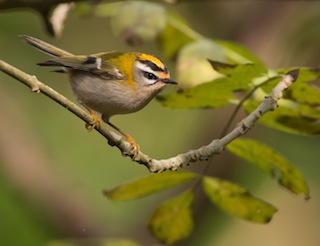 A flash of fiery bronze – watch out for flocks of beautiful Firecrests in the spring.
A flash of fiery bronze – watch out for flocks of beautiful Firecrests in the spring.
Photo: Dougy Wright
Scientific name: Regulus ignicapillus
Other common names: Common Firecrest
Conservation status: UK Birds of Conservation Concern, Green.
What to look for:
 • Colouring and appearance: Very small. White throat and underside, green on upper parts, yellow collar, black/white eye stripe, yellow and black on top of head. Males also have a deep orange cap on their heads.
• Colouring and appearance: Very small. White throat and underside, green on upper parts, yellow collar, black/white eye stripe, yellow and black on top of head. Males also have a deep orange cap on their heads.
• Size: Wingspan 13 to 16 cm, length 9 cm.
• Where: Mostly found in flocks in woodland, but also in gardens and hedgerows, often in the company of other birds such as Goldcrests. They breed in southern England, but are seen in the rest of the UK as visitors.
• Call: Repetitive high notes – listen here
• Similar to: Goldcrest.
The species name for this delightful and tiny bird – ignicapillus – means ‘fire-capped’, and so it is. The males in particular have a bright, almost glowing deep orange stripe on the top of their head, and both sexes are capped with a cooler flame of lovely yellow.
 Previously rated as Amber in the UK Birds of Conservation Concern, their status has now improved to Green. Even so, you need to keep your eyes peeled to spot them as they remain rarer than their Goldcrest cousins, with which they often form mixed flocks, dashing from tree to tree in search of their food of insects and spiders. In the summer there are approximately 550 breeding territories (source: BTO), mainly in southern England, but otherwise we see them as visitors and migrants.
Previously rated as Amber in the UK Birds of Conservation Concern, their status has now improved to Green. Even so, you need to keep your eyes peeled to spot them as they remain rarer than their Goldcrest cousins, with which they often form mixed flocks, dashing from tree to tree in search of their food of insects and spiders. In the summer there are approximately 550 breeding territories (source: BTO), mainly in southern England, but otherwise we see them as visitors and migrants.
Females lay their eggs (c. 7 to 12 per clutch) from late April into May, and commonly lay a second clutch, in June or July. Incubation (by the female) is for about 15 days, and the young fledge about eight to ten days after hatching.
Did you know…?
…The first British record of this species was from Cornwall, dating back to 1845.
More information and references:
Svensson, L., Mullarney, K., Zetterstrom, D.,1986. Collins Bird Guide, second edition (translated by Christie, D., Svensson, L.). HarperCollins, London.
Published: April 2018
Author: Amanda Scott
Photos: Dougy Wright (top); © Natural England/Allan Drewitt (middle), Tony Blunden (lower)
